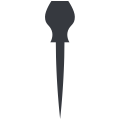The Real Carmen Freeze
In my other life, I wrote the puff pieces.
When I was 24, I was staying in Asheville for a few months to intern at a paper. I worked days at the paper and evenings at a coffee shop downtown. I wasn’t from Asheville — my parents had moved there a few years before, from Wisconsin — and I viewed my time there as temporary. This was all a long time ago — 1995. I had long hennaed hair, knocky teeth, and a voice so soft and apparently young sounding that when people phoned the paper they often thought they’d reached me in error. “But I want to speak to Carrie Frye.” “I am Carrie Frye,” I’d say, until eventually — on the third round or so — they believed me. I wore Adidas and a swingy miniskirt everywhere, and I had a degree from a college in Massachusetts that qualified me to be the sort of person who maintains vague but ardent plans of someday writing a book about the poet Frank O’ Hara. I had a small white dog named Sid I’d adopted as a stray in Austin when I’d lived there after college. The plan was, as soon as I had enough experience (that is, a resume more cohesive than “Golden Nozzle Carwash,” ‘Fort Worth Mortgage Company” and “vague but ardent plan to write a book about Frank O’Hara”), Sid and I would move to New York and I would get a job in publishing.
“The paper” was actually three papers, all monthlies. There was a business journal covering Western North Carolina; another one, for the upstate of South Carolina; and an arts journal. I had chosen to intern there by the careful selection process of “they would let me.” I feel I should emphasize here that it seemed like a legitimate place to work. It was small, yes, but there were big glassy offices and staff and ad people who, between phone calls, would stand on the sidewalk out front to smoke and gossip furiously. Or there was when I started. Two months into it, some sort of radical tumult happened and I found myself not an intern, but the papers’ editor, and I’d been installed in a little shoebox of an office on the sixth floor of an old, then dilapidated building downtown called the Flat Iron Building.
The office was a sublet in a suite of rooms belonging to the designer who laid out the paper. His name was Lowell, and I thought he was grim and disagreeable. The first time we’d met was when he’d visited the old office to do some darkroom work, and I had been nipping into that same room to heat up my internish lunch. I had said something like “Can I do this before you get started?”, and he said “No” and shut the door in my face. Then stayed in there FOR TWO HOURS. (We are now married.)
After the switch, I saw the paper’s publisher — I’ll call her Jessica — only two or three times a month, when she’d drive up to Asheville from South Carolina in her enormous SUV. She was in her 30s, had beautiful hair, and always wore the bright red suits and shiny heels of a predatory species of charismatic megafauna. We had nothing in common outside of work but I remember finding her entertaining, mostly. I enjoy flashiness and bravura, and she had a lot of both. If she sometimes lied — and you could tell when she was because that’s when she’d make the most intense eye contact — it felt un-malicious in intent. She seemed to like me well enough too. She would at least call to say things like, “I just gave the printer a check. MAKE SURE YOU DEPOSIT YOUR SALARY THIS MORNING.” If she was in town for the day, her assistant would come too, as well as the remaining ad exec, and the three of them would swirl around the outer office, making phone calls and gossiping furiously, and then they’d all leave, and it’d be quiet again.
The idea to use the name ‘Carmen Freeze’ came about with either the first or the second issues I edited. I had a small budget for freelancers, but I was responsible for the rest of the content, and I got it into my head, somehow, that it would look strange if half the articles in the three papers were written by Carrie Frye. So I invented the byline ‘Carmen Freeze’ to carry some of them. I thought it would look better.
The first article Carmen wrote was a puff piece about a home-goods store in South Carolina. I remember this one very clearly, even after all this time, because I noticed only a couple paragraphs in that Carmen was a better writer than I was. More elegant and light footed. She even punctuated better than I did. It was the strangest thing, like if you thought you were okay but a little plunky at the piano, and then one day, you could sit down and play beautifully, your hands rolling up and down the keys, but only if you called yourself Gigi Rachmaninoff. I wasn’t the only one who noticed either — people frequently called to ask for Carmen’s contact info.
After that first article, Carmen was assigned a couple pieces per month. I had some rules about it. She couldn’t write anything “reported” or a big feature story, as I thought those should go under my own name (I maintained a careening sort of ethics), but she could write puffs and other little features. A friend who’s asked to go by Elena here began to work part-time for the paper too, and she volunteered another of her aliases, ‘Hortense Brood,’ for some of her articles. She also gave the main paper the nickname by which I still think of it: The Blue Ridge Blowjob, even though at the time I was quasi-offended. (It might have been The Blue Ridge Blowjob, but it was my The Blue Ridge Blowjob, et cetera.)
Elena plays a part in the other anecdote I wish to tell you about this period. As I’ve said, the papers were monthlies, and they all went to press together. The week before was always brutal, no matter what. I’d work all day, flit out at dinnertime to grab something to eat, then hurry back to the office, to write articles and type in dumb business journal back-pages-type things until three or four in the morning. I was usually very fond of the Flat Iron Building. I liked the hand-operated elevators, and the two elevator operators, Ruby (mornings) and Janice (afternoons). I liked the way the smell of perms hit you as soon as you walked into the lobby, because of a beauty salon on the second floor. I liked the doors of the offices with their frosted panes of glass, like you’d expect to see for a detective agency. I liked the mysterious business names, and the way people ducked in and out without ever looking up or saying anything friendly. I liked the building’s deep well of quiet. All the same, I found it incredibly spooky at that time of night, when I was the only person still there. Or as I thought of it: the only person there?????????
The bathroom on our floor was two hallways away. The stall doors were high and wooden, like confessionals, and, when it was that time of night, I lived in fear that I’d hear the bathroom door start creaking open when I was inside one of them. It would have made a terrible Hitchcock movie: the lone business journal editor, stabbed or strangled in the Flat Iron john, her last words: “I. haven’t. finished. typing. in. Wachovia’s. profit. report.” Afterward, I’d skate back to the office and lock the door behind me. I’d sleep in a sleeping bag on the floor, then get up around 7 to make coffee and get back to it. The building would fill back up, the perm smell would begin to waft up the stairwell, and my creeping Hitchcock fears of the night before would start to seem ridiculous.
One month, when we were even further behind than usual, Elena decided to stay over too. Another friend of hers also had an office in the building, she said, and we could sleep there. When we were done for the night, we went down a couple flights of stairs and around the corner. Same dim hallway lights as my floor, same layout, similar row of darkened doors. She stopped at one and got out a key. When the door opened, I realized I’d been half-expecting this office to look like mine. It didn’t. There was no desk furniture, no computer, no beige carpet. Instead the room was filled with all sorts of odd, beautiful animal statuary from different parts of the world, and giant cushions — piles of them — for sitting on the ground (or, you know, sleeping on), and twinkling little lights. It was the strangest and most tranquil place. It’s what I’d wish for every writer on deadline, that they’d stumble into a room like that and get to sleep there a while.
I didn’t meet the friend the room belonged to until some time later. He was polite but aloof, in a way that made him hard to connect with the marvelous surprise of the room and how well I’d slept there. But that seems right too, for a story about one’s mid 20s: That there’d be all these different doors leading different places, and it wouldn’t always be clear which person matched up to which door, and which one ultimately would be the right one to go through.
Carrie Frye is a writer and editor living in Asheville, NC. She’s working on a novel about the Arctic and writes the Black Cardigan newsletter on the side.
In My Other Life, a collection of essays from writers we love, is The Awl’s goodbye to 2016.

